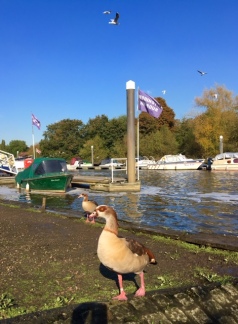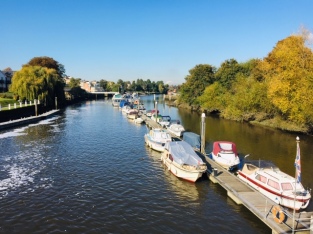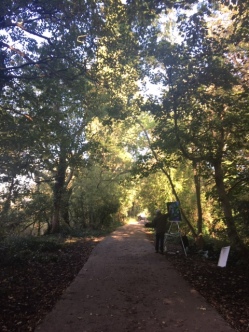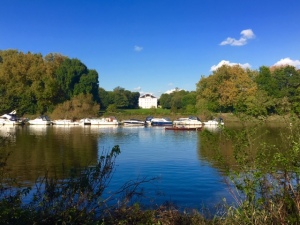October has been a strange month. The crispness of autumn has been replaced by what seems like endless rain and river levels have been extremely high – much higher than usual. I haven’t been able to go mudlarking this week – a combination of work deadlines and tides at the wrong time of day for me. But I’ve missed the river and at times like this there’s nothing like a Thames Path walk to lift your jaded spirits before winter kicks in with a vengeance. So, instead of my usual mudlarking finds blog this month, I’d like you all to accompany me on a riverside jaunt from Teddington to Richmond upon Thames.

I began my walk on a beautiful day, in fact the only day last week when there wasn’t a deluge of rain, and the conditions were perfect – blue skies and sunshine. Arriving at the start of the Thames Path walk in Ferry Road, Teddington, I strolled down to the water’s edge. The tide was out but this doesn’t mean much on this stretch of river as the embankment is very different in comparison with the landscape further downstream towards the City of London and beyond. The river is meandering here, not as fast flowing or deep, picture postcard pretty and with a different foreshore history from that of the Thames in the heart of London – less grit, more goose. Here you’re unlikely to find much in the way of historic artefacts or treasure of any kind but you might find a pipe stem, some sherds of plain Victorian porcelain or an interesting fossil. As far as the landscape is concerned, this is much more the Thames of Jerome K Jerome’s ‘Three Men in a Boat’ (although they’d need to avoid Teddington Weir…) than it is Joseph Conrad’s ‘Heart of Darkness’ with its powerful, brooding and much darker imagery of the river. But that doesn’t mean it’s less interesting. Just different.

As you cross over Teddington Lock footbridge there are spectacular views both down and upstream. It’s hard to know where to look first.

Upstream (right) towards Kingston you can see Teddington Weir in the distance. Although it’s relatively small as weirs go, its size is deceptive and it makes a heck of a noise as you approach it. A weir is basically a low head dam that alters the flow characteristics of water resulting in changes to the height of the river level. There are many different designs of weir but usually water will flow freely over the top of the crest of the weir before cascading down to a lower level. This is why they’re noisy beasts when you get close up to one, the powerful sound of rushing, foam-flecked water adding drama to the surrounding views.

Below is the view downstream (left) towards Richmond, a more placid, almost bucolic scene where the river is calm and still and pleasure boats, trees and river birds dominate your eye line. Every time I cross Teddington Lock footbridge and look in this direction there’s usually a grumpy heron flying overhead and landing on one of the embankments.

Once I’d made it across the river to the Surrey side of the Thames there was still some stunning autumnal foliage on display; dahlias, wildflowers, rosehips and a few blackberries left among the brambles for a lucky field mouse or two.

Here the Thames Path routes are well sign-posted and mapped out clearly for you to follow. It’s difficult to get lost, even if you’re completely new to the area. Once I’d reached the Surrey embankment I was primarily on the hunt for the famous Teddington obelisk, so I turned and headed downstream.

After a few minutes of brisk walking I reached Teddington Lock, the Lock Keeper’s cottage shown in the photograph below. Teddington Lock was originally built in 1801, of timber, which predictably began to rot fairly quickly and was soon no longer fit for purpose . It was replaced in 1856/7 with the building we see today and Jonathan Thorp Esquire laid the first stone.

In front of the Lock Keeper’s House is a moving walkway, not accessible to the public, leading to a tiny shed-like building. This should be familiar to Monty Python fans as it’s the site of the famous fish-slapping dance sketch. The Python team regularly filmed at Teddington Studios, which used to be a short walk away from here but was unfortunately demolished a couple of years ago in order to make way for luxury riverside flats; another piece of our televisual heritage now disappeared from the local area thanks to property developers. It’s particularly poignant for me because I have wonderful memories of going to Teddington Studios with my family to see many top BBC comedy shows being recorded there.


Leaving the Lock Keeper’s cottage and my memories of Teddington Studios behind me I continued walking downstream. After approximately ten minutes, I passed a mysterious little glade, set back from the main path, and there it was – the famous obelisk that marks the beginning of the Tidal Thames. I’d found what I was looking for, tucked away and hidden discreetly behind a protective circle of metal railings, autumn leaves falling gently around it every time a gentle breeze rustled through the trees.

The obelisk marks the point where the legal powers of the London Port Authority, responsible for navigation from Teddington downstream to the Estuary and out to the North Sea, morph into those of the Environment Agency who take over this role from Teddington upstream to the headwaters of the Thames. I was taken aback by the fact that you could easily walk straight past this point and not even notice the obelisk is here. In fact, while I was taking photos of it for my blog, a retired couple out for a stroll stopped to ask what the obelisk was, thinking it was perhaps a monument to a local dignitary or to the war dead. When I explained to them what it actually was they were taken aback as they wouldn’t have noticed it if they hadn’t seen me there.


Perhaps this is a bit corny but it was a special moment to be able to touch the stone at the base of the obelisk. The metal fencing around it stops visitors from being able to touch the main body of the monument and local vandals from daubing unsolicited graffiti on it. It’s well protected. However, I don’t recommend pushing your arms through the bars as you’ll probably get stuck and it would be a shame to end this Thames Path walk having to be cut free by the emergency services. But it is possible to touch the base of the stone as you pay homage to the place that is officially the start of the Tidal Thames. If this isn’t already, it should definitely be a little ritual for all mudlarks.
Once you’ve spent your moments communing with the Teddington Obelisk, continue walking downstream towards Richmond where you’ll pass Ham Lands. Here you might well come across a painter at his easel on the pathway, a squadron of low flying geese, nature reserves, ancient reedbeds, song thrushes, kestrels and the common soprano pipistrelle bat.

Approximately twenty minutes later and you should find you’re passing Eel Pie Island on your left, an 8.9 acre island in the river at Twickenham, accessible only by boat or footbridge. The historically famous eel pies are a bit thin on the ground these days but Eel Pie Island is now best known for being an iconic blues and rock venue where in the 1960s you could see the Rolling Stones play live at the Eel Pie Island Hotel, the building long since burnt to the ground. In addition to the Stones, fans could also come here to see The Who, Pink Floyd, Long John Baldry’s Hoochie Coochie Men, The Yardbirds, Eric Clapton, and a young David Bowie. Nowadays the island is home to a thriving artistic community who regularly hold open house sessions in their studios during the summer months.
Continuing further past Eel Pie Island, a few more minutes of brisk walking will see you drawing parallel with a beautiful and elegant building across the river on your left, visible through a gap between the trees on the north bank. This is the stunning façade of Marble Hill House, Twickenham. (NB: Twickenham, although in South West London, is actually north of the Thames while Richmond is on the south or Surrey side of the river. This can be confusing as both are neighbours, separate political constituencies, but sharing the same local borough ie: the London Borough of Richmond upon Thames.)

Marble Hill House is essentially a Palladian-style villa designed by Roger Morris and Henry Herbert, built between 1724 and 1729. Herbert, also known as the Earl of Pembroke, based the villa on Andrea Palladio’s Villa Cornaro in Italy, incorporating many of the symmetrical and classical features, plus the grand interiors of Palladio’s villa, into Marble Hill. The view you can see in the photograph above is the rear, which was once ironically the front entrance to the house because it was accessed from the river, which would have brought visitors to this location via boat or barge in the 18th and early 19th centuries when roads were either impassable or dangerous to use due to the very real threat of robbers and highwaymen. The house and gardens were intended as an Arcadian retreat from the stench, filth and horror of 18th century London.
Marble Hill was originally the home of Henrietta Howard, Countess of Suffolk, who lived there until her death in 1767. Cultured and educated, she was the mistress of King George II and the villa was built as a gift from the King although he stipulated that the building must be free from any interference from Henrietta’s estranged and unpleasant drunk and debt-ridden husband, Charles Howard, the Earl of Suffolk . The Countess regularly hosted spectacular literary salons at Marble Hill and was the friend and confidante of both Alexander Pope, a neighbour living nearby in Strawberry Hill House, and Jonathan Swift who also regularly visited her here. Marble Hill House is now owned by English Heritage who are responsible for managing both the house and the 66 acres of stunning riverside grounds and parkland that surround it.

Leaving behind the views of Marble Hill House across the river, focus again on the Thames Path in front of you towards Ham. As you continue walking, you’ll see a gap in the clearing to your right which will give you a first view of stunning Ham House and gardens. Both are well worth a visit.
Ham House was originally built in 1610, the creation of the enterprising and ambitious William Murray, who as a boy had been educated with the young Charles I. The King gifted the lease of Ham House to William in 1626, after which William and his daughter Elizabeth transformed the house into the splendid residence we see today – a rare and perfect example of 17th century Jacobean splendour, luxury and fashions. Elizabeth Murray, later Duchess of Lauderdale through her second marriage, transformed Ham House into one of the grandest Stuart houses in England. After Elizabeth’s death, Ham House remained in the hands of her descendants from her first marriage within the Tollemache family. It’s well worth a visit if you haven’t been.
Continue downstream along the river and, if you look up, you’ll see the red brick façade of the Star and Garter building straddling the top of Richmond Hill. The Star and Garter Home was built between 1921-1924 to provide accommodation and nursing facilities for 180 seriously injured servicemen, much like the Royal Hospital at Chelsea, although it was sold a while ago to property developers and has now been converted into luxury apartments. Nearby, on the Petersham Road, is the Poppy Factory, built in 1922, where hundreds of thousands of poppies are made every year for The Royal British Legion’s annual Poppy Appeal.
A path will take you up to Terrace Field where you can see spectacular views across the Thames towards Twickenham and beyond. In 1819, the painter J.M.W. Turner stood on this spot and painted this famous London scene, the landscape stretching before him across Richmond Hill towards the river. The painting was Turner’s attempt to attract the patronage of the future King George IV, which he failed to get as the then Prince of Wales thought the painting was pretentious and out of touch with the political upheaval of the times. Nonetheless, Turner’s idyllic landscape now hangs in the Tate collection.

Sir Mick Jagger still owns a home at the top of Richmond Hill and across the road, near the Star and Garter building, is a beautiful Georgian house once owned by the late actor, Sir John Mills and his family.
To conclude this Thames Path walk, make your way back down Terrace Field. Here the path leads inexorably on towards Richmond Bridge but if you’re shattered, in need of sustenance and a bit of a sit-down after your nearly eight kilometre walk, then I recommend stopping at Stein’s for lunch. This is a popular German restaurant serving Bavarian dishes such as their outstanding schnitzel, bratwurst, currywurst or nürnberger, washed down with a pint of Stein’s famous German Dunkel beer.
Enjoy! You’ve deserved it.

Thanks for a great post I really must try to do this walk!
LikeLike
Thank you, Anne. A beautiful walk. I thoroughly recommend it.
LikeLike